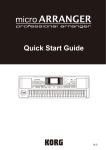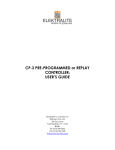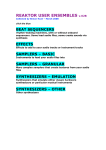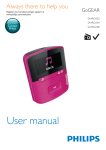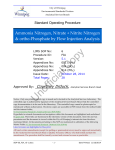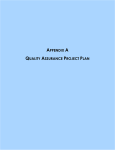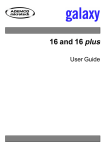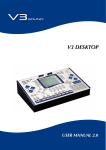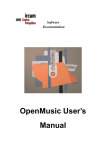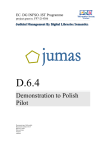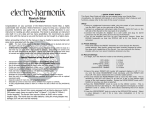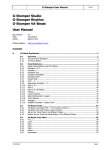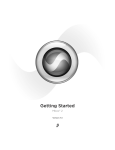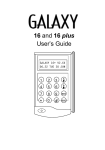Download MIDIpal user manual
Transcript
MIDIpal user manual The MIDIpal is a powerful MIDI processor – like a multi-effect operating on MIDI data! It features 19 different MIDI “apps”, ranging from MIDI debugging or routing utilities (monitoring messages, remapping a channel to another one…) to complex compositional or inspirational tools like arpeggiators or pattern generators. Overview Basic setup Connect a MIDI message source, such as a keyboard, control surface or computer interface to theMIDI in port of the MIDIpal. Connect a MIDI message receiver, such as a synth module, expander, or computer interface to theMIDI out port of the MIDIpal. The MIDIpal can be powered by either a 9V battery or a 5V-9V unregulated DC supply, with a minimum current rating of 150mA. Make sure that the connector has a center pin (or tip) positive / outer collar (or sleeve) negative pin polarity. Most universal power supplies allows the polarity to be selected — the polarity being often represented by a diagram like this: – (o +, or by the indication tip: +. User interface Incoming and outgoing MIDI signals are visualized by the red and green LEDs near the MIDI sockets. The 8 characters LCD display is used to display the name and value of the currently edited parameter. Editing is done with the clickable rotary encoder. Launching apps Each “feature” of the MIDIpal can be seen as an independent “app”. Only one app can be running at a time – that is to say, you cannot run an arpeggiator, a drum sequencer and a MIDI monitor on the same unit! To select the app to use, keep the encoder pressed. The name of the current app is shown on the screen. sequencr Turn the encoder to select an app. Click on the encoder to launch this app. Note that the last three entries in the list are not regular apps: • • • notenuke sends a NoteOff message, for all possible MIDI notes, on all MIDI channels. sysxdump outputs a SysEx backup of all the MIDIpal settings. !reset! resets the unit to its factory settings. Navigation within an app Though there are a few exceptions, most of the apps are operated the following way: Turn the encoder to scroll through the lists of parameters. bpm 123 If you want to change a parameter, click on the encoder. Brackets appear around the parameter value. bpm[123] Turn the encoder to increase or decrease the value. Click again once you are done. bpm 123 The brackets disappear, and your modification is kept in memory, even if the MIDIpal is powered down – no need for a save button! Reverting to factory settings In order to revert the MIDIpal to its factory settings, keep the encoder pressed for 2s to display the app list. Scroll to the end of the list to reach the !reset! item: !reset! Click the encoder. Kaboom! All your settings are lost to the factory defaults. Apps Please note that some of these applications might not be available on your unit. Please refer to this page and to the firmware update section to find out how you can replace the standard MIDIpal firmware with alternate versions containing extra applications. Debugging apps MIDI monitor (monitor) This app monitors the incoming MIDI traffic. The MIDI data itself is passed through the MIDI output – so you can insert it through a MIDI link in your home studio to look at what’s going on… chn all Press the encoder to select the MIDI channel to monitor. By default, all channels are monitored. The monitor displays the following text for note on/off messages: 1*A#4 3f • • The first character is the MIDI channel. A star is displayed as the second character whenever an active sensing message is received. A dot is displayed whenever a MIDI clock message is received. • • The next 3 characters are the MIDI note number is displayed. The last 2 digits are the velocity value in hexadecimal, or ‘—’ for a note off message. The following text indicate a note pressure (aftertouch) message – ‘a’ for aftertouch, 7 being the highest nibble of the aftertouch value. 1*A#4 a7 The following text indicates a channel pressure (aftertouch) message. 1*aft 7e The following text indicates a CC #30 message. 1 #30 70 The following text indicates a pitch bend message of value 0x3070 on channel 4. 4 b 3070 Here is a list of text messages displayed for less common MIDI messages: • • • • • • • • • • • • notoff: all notes off controller. omnoff: omni mode off controller. omnion: omni mode on controller. monoon: mono mode on controller. polyon: poly mode on controller. sysx..: beginning of SysEx reception. .sysx.: SysEx reception in progress. ..sysx: end of SysEx reception. start: clock start. cont.: clock continue. stop: clock stop. reset: system reset. BPM meter (bpm cntr) This app estimates and displays a BPM value from the MIDI clock. Every incoming MIDI data is forwarded to the MIDI out. Rotate the encoder to switch between the following views: b 120.0 BPM estimated over the past half-second B 120.0 Average BPM (estimated since the clock was started) t 23307 Total number of clock ticks received Click the encoder to reset the BPM estimate and the clock tick counter. MIDI Plumbing apps Channel filter (chnfiltr) This app deletes from the MIDI stream all messages associated with one or many MIDI channels. chX off Enables or disable the MIDI channel X. Splitter (splitter) This app routes MIDI note messages (note on, note off and aftertouch) from a specific channel to a different MIDI channel depending on their note value. For example, if you have a keyboard emitting on channel 1, you can use the lower half of the keyboard to send notes to a bass synth listening on channel 1, and the upper half of the keyboard to send notes to a multitimbral expander listening on channel 3. inp 5 Input channel. spl B3 Split point. low 7 Notes below the split point, coming from the input channel, will be routed to this channel. upp 7 Notes above the split point, coming from the input channel, will be routed to this channel. Dispatcher (dispatch) This app routes MIDI note messages from a single channel to several channels. This allows you to play chords on a rack of monophonic synths, for example. inp 5 Input channel. mod cyc Dispatching method: • cyclic (*cyc*). Each new note is cyclically played on the next channel. • polyphonic (*pol*). The mapping of notes to channel uses a true voice stealing algorithm. The MIDIpal tries to reuse the same channel for occurrences of the same note ; or the least recently used channel. • random (*rnd*). Each new note is routed to a random channel. • stacking (*stk*). Each note is sent to all channels at the same time. Perfect for thickening a lead by sending it to several synths, or to several parts of the same multitimbral device. • velocity (*vel*). The louder (higher velocity) the note, the higher the MIDI channel it is sent to. out 4 First output channel. num 3 Number of output channels. For example, if out = 4 and num = 3, the notes will be dispatched to channels 4, 5 and 6. Channel merger (chnmergr) This app merges data from several channels into a single one. inp 5 First input channel. num 3 Number of channels to merge. For example, if inp = 5 and num = 3, channels 5, 6 and 7 will be merged. out 2 Output channel. Clock divider (divider) This app forwards every incoming MIDI message, but it only pick every Nth clock message. This has the effect of slowing down the MIDI clock by a ratio of N. div 1 Ratio by which the MIDI clock is divided. Sync latch (syncltch) This feature, inspired by the Mungo Sync allows a slave device to be synchronized and started/stopped in sync with a master device playing a loop. Consider the following situation: you have a drum machine playing a steady 2-bar loop, in 4/4, and generating a clock signal for a slave MIDI sequencer. You need to reload a pattern on the sequencer. You stop the sequencer, load the pattern, and then you need to hit the play button on the sequencer at the exact right moment so that it starts spot on the first beat of the 2-bar drum loop. Tricky isn’t it? This is where the MIDIpal can be used. Insert it between the drum machine and the sequencer. Configure the duration/time signature of the loop (Here: 8 quarter notes). The MIDIpal will keep counting beats. When you press the MIDIpal encoder, it’ll wait for the beginning of the loop and then send a start message to the MIDI slave. When you press again the MIDIpal encoder, it’ll wait for the end of the loop and then send a stop message to the MIDI slave. num 4 den 1/4 Numerator and denominator of the time signature of the loop. 03:00 . Beat counter. This shows: • the MIDIpal counting beats. • whether the slave is playing or stopped (a dot is shown when the slave is stopped ; a “>” sign is shown when the slave is running). • whether the MIDIpal is ready to send a start/stop message to the slave. When you press the encoder, the beat count is shown in brackets, to indicate that the MIDIpal is waiting for the beginning of the next bar to send the Start message (or the end of the bar to send theStop message). For example: [03:20]. Indicates that the slave is currently stopped, and that the MIDIpal is waiting for the beginning of the next bar to send a Start message. [01:10]> Indicates that the slave is currently running, and that the MIDIpal is waiting for the end of the bar to send a Stop message. Controller and master apps. Clock source (clock) This app acts as a clock source – regularly sending MIDI clock (0xf8) messages. Every incomingMIDI data, at the exception of MIDI clock messages, are forwarded to the MIDI out. The settings are the following: run off Starts or stops the clock. bpm 120 Tempo of the internal clock, in beats per minutes. grv swg Type of shuffle/jitter to apply to the clock: • • • • • • swg: swing shf: shuffle psh: push effect, anticipating the beats lag: lag effect, delaying the beats hum: humanization mnk: monkeyzation amt 80 Amount of shuffle/jitter to apply to the clock. tap 120 While on this screen, you can “click” on the encoder to tap a tempo. High-resolution clock source (clock) This variant of the clock app acts as a clock source with a finer resolution of 0.1 BPM. Both variants perform equally well in terms of jitter/accuracy – this version just has a finer range of adjustment. The settings are the following: run off Starts or stops the clock. 120.0 Tempo of the internal clock, in beats per minutes. CC and NRPN knob (cc knob) This app turns the MIDIpal into a MIDI controller – sending CC or NRPN messages. All incoming messages are sent to the output — that is to say, the generated CC/NRPN messages are merged into the MIDI stream. The settings are the following: val 60 CC or NRPN value to send. chn 7 Channel on which the CC message has to be sent. typ cc# Type of message to send: CC or NRPN. num 7 Number of the CC or NRPN message to send. For example, set this to 7 to send a volume message. min 0 max 80 Value range. This restricts the range of the val setting on the first page. Controller (contrllr) This app is only useful if you dare opening your MIDIpal. On the circuit board, you will find 8 pads labelled Analog 1..8 to which you can connect any circuit (including a simple potentiometer voltage divider) outputting a voltage in the 0-3.3V range. These are connected to the analog to digital converter of the MIDIpal brain. Voltage changes on these inputs will be translated into CC messages: a voltage of 0V yields a CC value of 0 ; a voltage of 3.3V yields a CC value of 127. Note that by default, these pads are floating, so they will receive random values! And beware: values above 3.3V are likely to destroy your MIDIpal. The following settings are available: chn 8 Channel on which the CC messages will be sent. ccN 7 CC# associated with the Nth input. Inspiration/composition apps Drum pattern generator (drums) This app generates 4-part rhythmic patterns on a selected channel (preferably 10!). You can use a 49 keys keyboard (or larger) to start, stop and mutate the patterns. The first octave on a 61 keys keyboard (C2 to B2) controls the first part. The second octave (C3 to B3) controls the second part. And so on. Two types of rhythmic patterns are available: • Preset patterns: Each key within an octave will trigger and loop a different 1-bar pattern. C mutes the part. • Euclidean patterns: Pressing a key in an octave indicates how many notes should be played within the span of a bar (C is 0, C# is 1, D is 2, D# is 4, then 5, 6, 8, 10, 12, 14, 16). Pressing two keys indicate how many notes should be played within the span of a sequence + the duration of a sequence. For example, if you press D and E, a 5 steps long pattern, containing 2 evenly spaced notes will be played. You can safely ignore these instructions and just play keys and clap your hands. The following settings are available: mod ptn Switch between the preset patterns and the euclidean patterns modes. clk int Select an internal or external clock source. When using an external clock source, start, clock and stopMIDI messages must be sent. bpm 120 Tempo of the internal clock, in beats per minutes. grv swg Type of shuffle/jitter to apply to the clock. amt 80 Amount of shuffle/jitter to apply to the clock. chn 10 Channel on which the notes are sent. This is also the channel to which pattern triggers must be sent. pt1 C1 pt2 D1 pt3 A#1 pt4 C#1 MIDI Note to send when a note is triggered on parts 1, 2, 3, 4. Notes are sent with a velocity of 100, and have a duration of one sixteenth note. Randomizer (randomiz) This app randomizes the note and velocity values of the incoming MIDI data. It can even send a random CC every time a new note is triggered! chn 8 Channel on which the randomization effect is applied. amt 99 How often randomization is applied. When this value is set to 127 (maximum value), every note is randomized. When this value is set to 63 (medium value), there is a 50/50% probability that a note will be randomized. When this value is set to 0, no randomization is applied. not 1 Amount of random modulation applied to the note number, in semitones. For example, if this parameter is set to 12, the emitted note is within +/- 12 semitones = +/- 1 octave of the original note. vel 70 Amount of random modulation applied to the velocity value. cc1 70 cc2 70 Amount of random modulation applied to the first and second CC. Set both to 0 if you don’t want to send a random CC with each note. #c1 7 #c2 7 CC Numbers for the first and second random CC sources. Chord memory (chordmem) This app memorizes a chord and lets you play transpositions of it. To record a chord, click the encoder, and play a chord. Click the encoder again and that’s it maestro! In recording mode, you can also select the affected channel. Arpeggiator (arpeggio) clk int Select an internal or external clock source. When using an external clock source, start, clock and stopMIDI messages must be sent. bpm 120 Tempo of the internal clock, in beats per minutes. grv swg Type of shuffle/jitter to apply to the clock. amt 80 Amount of shuffle/jitter to apply to the clock. chn 1 Channel to arpeggiate. Chords sent on this channels are filtered out and played as arpeggios. dir up Arpeggio direction. The available directions are up, down, up&down, or random. oct 1 Arpeggio range, in octaves. ptn 10 Arpeggio rhythmic pattern. 1: o o o o o o o o oo o oo o 2: o o ooooo o oooo 4: o o o ooo o o oo 3: o o oo 5: o o o o oo o o o 6: o o o o o o o 9: o o o o oo o o o o 12: o 14: oo oo o oo oo o oo oo oo o o oo o o o 10: o oo 22: o o o o 8: o o o o o o 11: o o o o oo 13: oo o oo oo o oo 15: ooo ooo ooo ooo 17: ooo o o ooo o o 19: ooooo oo oo ooo oooooo oo 7: o o o 20: o o 16: ooo oo 18: oooo oo oooo oo o o o o o 21: o o oo div /16 Duration of an arpeggio step (the duration of a ‘o’ or blank in the previous chart). The default is /16 — a 16th note per step. dur /16 Duration of the notes played by the arpeggiator. The default is /32, a 32th note. lat on Latch mode. When set to on, releasing the keyboard will not stop the arpeggiator. To stop the arpeggiator, set this latch setting to off. Please note that the sustain pedal of your controller can be used similarity to hold notes. Tempo-synchronized delay/strummer (delay) This app adds echoes to incoming note on and note off messages. The echo duration is specified as a fraction of the duration of a bar – thus, this effect can be musically synchronized to a tempo clock (be it internal or external). clk int Select an internal or external clock source. When using an external clock source, start, clock and stopMIDI messages must be sent. bpm 120 Tempo of the internal clock, in beats per minutes. grv swg Type of shuffle/jitter to apply to the clock. amt 80 Amount of shuffle/jitter to apply to the clock. chn 1 Channel on which the echo effect is applied. del 1/4 Delay duration, expressed as a fraction of a bar. For example, when this is set to 1/4, the duration between echoes is equal to the duration of a quarter note. rep 8 Number of echoes to play. Note that when a complex sequence is played with many overlapping echoes, the internal scheduler buffer can overflow. In this case, a ‘!’ symbol briefly appears on theLCD display. Keep in mind that each echo is going to use a polyphony voice, so it is not a good idea to play MIDI echoes on a device with a limited polyphony. vel 16 Velocity dampening. When this value is low, the echoes have a small and rapidly decreasing velocity. When this value is high (the maximum being 16), all the echoes are played with the same velocity as the original note. trs 0 Number of semitones by which each echo must be transposed. dpl 32 Pseudo-doppler effect: Increases (when set to a positive value) or decreases (when set to a negative value) the delay between the notes as they echo. Scale and harmony processor (scale) This app can transpose incoming note messages, and “quantize” them to the nearest note in one of the 25 preset scales. It can also harmonizes the incoming note at a fixed interval and/or through algorithmic modification of the played melody. chn 1 Channel on which the scale / transposition / harmony modifications have to be applied. roo C Root note of the target scale. scl chr Target scale. All notes outside of this scale are “quantized” to their nearest neighbor in the scale. For example, if a C major scale is selected, and if you play a chromatic scale (C, C#, D, D#, E…), what will be heard will be C, C, D, D, E, F, F, G, G, A, A, B. The available scales are: • • • • chr: chromatic scale (no quantization). ion: ionian mode (major scale). dor: dorian mode (russian minor scale). phr: phrygian mode. • • • • • • • • • • • • • • • • • • • • • lyd: lydian mode. mix: mixolydian mode. aeo: aeolian mode (minor scale). loc: locrian mode. bmj: major blues scale. bmn: major blues scale. pmj: pentatonic major scale. pmn: pentatonic minor scale. bhr: raga Bhairav. shr: raga Shri. rup: raga Rupavati. tod: raga Todi. rag: raga Rageshri. kaa: raga Kaafi. meg: raga Meg. mlk: raga Malkauns. dpk: raga Deepak. flk: Folkish scale. jap: Japanese scale. gam: Gamelan scale. whl: Whole tones. trs 0 Transposition to apply to the incoming notes. voi 0 When set to a non-zero value, a parallel harmony N semitones apart from the incoming melody is played. For example, when set to -24, the incoming notes are doubled 2 octaves below. Note that the generated notes are also subject to scale quantization. hrm off Generates an additional, mostly random, harmonic line on top of the incoming melody. Several algorithms are available to generate the harmony: • mir: mirrors the intervals played on the incoming melody. If you play an ascending scale, a descending scale will be added. • • alt: alternates between following what you play, and the mirror mode. trk: tracks the interval you play, plus or minus a few semitones. For example, if you play a fifth, a major third, and an octave, the harmonized line might play a fourth, a minor third, then an octave. • random: plays a random note within +/- 1 fifth of the note you played. Obviously, all those random modifications are likely to generate annoying junk unless you select a scale. In which case, it will still sound random, but of the “Free-Jazz” flavor of random. Step sequencer (sequencr) This app is a step sequencer which can generate note messages, CCs, or a combination of both, on up to 32 steps. The following settings are available for each step: • Note (represented on the screen by a note icon). • Note duration (represented on the screen by a pulse icon). • Note velocity (represented on the screen by a triangle icon). Set the velocity to 0 to mark a step as being a rest. • CC value (represented by a knob icon). Since navigating between the 32 steps x 4 settings = 128 pages can be tedious, you can “simplify” the sequencer operation by: • Muting the notes track. In this case, the sequencer only sends CC – and works more like a programmable MIDI LFO. • Muting the note duration track. In this case, a default note duration of 1 step will be used for all the generated notes. • Muting the velocity track. In this case, a default velocity of 100 is used for each step. • Muting the CC track. In this case, the sequencer only sends note information. The muting/unmuting of those track can be used for creative effects — for example, you can temporarily mute the velocity track of a synth sequence to make it sound louder and more mechanical. The sequencer has many settings pages, described in this section. run off Start or stop the sequencer, when it is synchronized to the internal clock — When the sequencer is synchronized to an external MIDI clock, a proper start/stop MIDI message must be sent for the sequence to start. You can also start the sequencer by playing a MIDI note, and stop it by replaying the same note. clk int Select an internal or external clock source. When using an external clock source, start, clock and stopMIDI messages must be sent. bpm 120 Tempo of the internal clock, in beats per minutes. grv swg Type of shuffle/jitter to apply to the clock. amt 80 Amount of shuffle/jitter to apply to the clock. div /16 Duration of a step, in a fraction of a bar. The most common setting (TB303-like) is one sixteenth note (/16) per step. chn 1 MIDI channel on which the sequenced events will be sent. cc# 7 CC number of the messages sequenced on the CC track. not on Whether the sequencer sends note messages. dur on Whether the note duration track is active. When this track is disabled, all notes played by the sequencer have a duration of 1 step. vel on Whether the velocity track is active. When this track is disabled, a note is played on every step, with a velocity of 100. cc on Whether the CC track is active. stp 8 Number of steps a sequence is made of. 01N C3 Note for step 1. 01D /96 Duration of the note played at step 1 – here, 1 MIDI clock tick. 01V 14 Velocity for step 1. The actual MIDI velocity value sent is 8 times the displayed value. For example, 15 corresponds to the velocity value 120. 01C 63 Value of the CC sent at step 1. Some nice things about the sequencer: • While a sequence is playing, you can transpose it by playing a note on the keyboard. The transposition is relative to C3 if the sequence was started from the menu or from an external MIDIclock ; or relative to the pressed key when the sequence was started from the keyboard. • While the MIDIpal is in editing mode, on a note step (in other words, when the screen is displaying something like 01N[ C3] ), pressing a key on the keyboard does not transpose or start the sequence. Instead, it records the played note at the current step. SH-101 style Sequencer (sequencr) This variant of the sequencer app provides a very simple way of recording sequences from a keyboard and playing them back with transposition. To record a sequence, turn the encoder until the display shows: rec off Click the encoder to enable recording. The display shows the number of the current step (here, 0): . 0|rest Every note played from the MIDI in is added to the sequence. • To insert a rest (blank step), click the encoder. • To insert a tie (extends the duration of the previously input note into this step), turn the encoder to select “tie” and click. • To insert an accent, move the modulation wheel up before playing a note – this note will be accented. • To insert a slide between two notes, wiggle the pitch bend lever (the actual position does not matter) between the two notes. • To leave the recording mode, turn the encoder to select “exit” and click. There are different ways of starting the play-back of the recorded sequence: • Turn the encoder until the display shows the “run” option and click. • Play a note from the MIDI keyboard connected to the MIDIpal – you can transpose the sequence by playing a different note. The sequence stops if you move back to the original note used to start the sequence. • If the MIDIpal is configured to receive an external MIDI clock, send a MIDI start message. The other settings available are: clk int Select an internal or external clock source. When using an external clock source, start, clock and stopMIDI messages must be sent. bpm 120 Tempo of the internal clock, in beats per minutes. grv swg Type of shuffle/jitter to apply to the clock. amt 80 Amount of shuffle/jitter to apply to the clock. div /16 Duration of a step, in a fraction of a bar. The most common setting is one sixteenth note (/16) per step. chn 1 MIDI channel on which the sequenced events will be sent, and from which events will be recorded. JX-3P style Sequencer (polyseq) This sequencer app inspired by JX-3P sequencer allows layer by layer recording of polyphonic sequences. Think of it as a polyphonic version of the SH-101 style sequencer. To clear the sequence and record a first layer, turn the encoder until the display shows: rec off Click the encoder to enable recording. The display shows the number of the current step (here, 0): . 0|rest Every note played from the MIDI in is added to the sequence. • To insert a rest (blank step), click the encoder. • To insert a tie (extends the duration of the previously input note into this step), turn the encoder to select “tie” and click. • To leave the recording mode, turn the encoder to select “exit” and click. To record a new layer above the existing sequence (overdub mode), turn the encoder until the display shows: dub off Click the encoder to enable overdubbing. From there, you can record notes/ties/rests just like in the record mode. Note that once you reach the end of the sequence, the step counter goes back to 0 and you can record a new layer above the previous one. There are different ways of starting the play-back of the recorded sequence: • Turn the encoder until the display shows the “run” option and click. • Play a note from the MIDI keyboard connected to the MIDIpal – you can transpose the sequence by playing a different note. The sequence stops if you move back to the original note used to start the sequence. • If the MIDIpal is configured to receive an external MIDI clock, send a MIDI start message. The other settings available are: clk int Select an internal or external clock source. When using an external clock source, start, clock and stopMIDI messages must be sent. bpm 120 Tempo of the internal clock, in beats per minutes. grv swg Type of shuffle/jitter to apply to the clock. amt 80 Amount of shuffle/jitter to apply to the clock. div /16 Duration of a step, in a fraction of a bar. The most common setting is one sixteenth note (/16) per step. chn 1 MIDI channel on which the sequenced events will be sent, and from which events will be recorded. LFO (lfo) This app generates slowly evolving controllers for up to 4 individual CC. Note that there are a few fundamental differences between what this app does and what an LFO on a synth traditionally does: 1. The stream of CC is generated at a slow speed, typically 50 samples per second. 2. Instead of controlling the LFO frequency in Hz, you control here the duration of a cycle expressed as a musical duration relative to a tempo. run off Start or stop the LFOs, when it is synchronized to the internal clock — When the LFO is synchronized to an external MIDI clock, a proper start/stop MIDI message must be sent for the LFOs to start. clk int Select an internal or external clock source. When using an external clock source, start, clock and stopMIDI messages must be sent. bpm 120 Tempo of the internal clock, in beats per minutes. grv swg Type of shuffle/jitter to apply to the clock. amt 80 Amount of shuffle/jitter to apply to the clock. res /96 Resolution of the LFO clock. Selecting a high resolution allows for faster modulations and less stepping, but some devices might not like the very dense MIDI streams this generates. Selecting a low resolution might create “stepping” effects. chn 1 MIDI channel on which the CC messages will be sent. ccN 7 CC number sent by the Nth LFO. amN 63 Modulation amount of the Nth LFO. A negative amount inverses the polarity of the LFO waveform. ceN 63 Center value of the Nth LFO. For example, if the modulation amount is 40 and the center value 70, the LFO will oscillate between 70 – 40 = 30 and 70 + 40 = 110. wfN tri Waveform of the Nth LFO. The following waveforms are available: • • • tri: triangle sqr: square rmp: ascending ramp. Use a negative modulation amount to get a descending ramp. • • • • • • • • • • • • • • • sin: sine wave si2: first and second sine harmonics si3: first and third sine harmonics si5: first and fifth sine harmonics gg1: gurgle gg2: double gurgle bt1: bat (folded triangle) 1 bt2: bar (folded triangle) 2 sp1: spike sp2: bipolar spike lp1: smoothed ramp lp2: smoothed square rs1: ramp with overshoot rs2: square with overshoot s&h: (random) sample&hold A large fraction of those waveforms has been approved by the International Organization for Dubstep Standardization. rtN 1/8 Period of the Nth LFO. For example, if this is set to 1/4, the LFO will complete a whole cycle every quarter note (beat). syN fre Sync mode of the Nth LFO. The synchronization modes are: • fre: free running. The LFO oscillates independently of any note message, and its phase is never reset. • not: note synchronization. The LFO phase is reset to 0 every time a note on message is received. • chd: chord synchronization. The LFO phase is reset to 0 every time a new “chord” is received. In other words, as long as a note is held, playing new notes will not reset the LFO phase. You need to release all keys and press a new key to reset the LFO phase. Miscellaneous apps Tanpura pattern generator (tanpura) This app generates the repetitive note patterns traditionally played on the tanpura to accompany north indian classical music. The settings are the following: run off Starts/stops playback. clk int Select an internal or external clock source. When using an external clock source, start, clock and stopMIDI messages must be sent. bpm 120 Tempo of the internal clock, in beats per minutes. grv swg Type of shuffle/jitter to apply to the clock. amt 80 Amount of shuffle/jitter to apply to the clock. res 1/4 Relationship between the tempo grid (BPM) and the notes. The default is 1/4. 1/8 and 1/16 can be used for double and quadruple time. chn 1 MIDI channel on which the note messages will be sent. sa C4 Root note (sa) of the pattern. mod pa Interval highlighted in the pattern. Pa = fifth, ma = fourth, ni = 7th, sa = only octave. cyc 5 This setting indicates from which note the pattern starts. For example, considering the pattern: sa . . . . pa Sa Sa sa. 0 will start the pattern at sa ; 1, 2, 3, 4 will start the pattern by a silence ; 5 will start the pattern at pa ; 6 and 7 will start the pattern at Sa. Ear training game (ear game) This app is an ear training game. A few notes are played on the MIDI output (on channel 1). You need to play them back on the keyboard connected on the MIDI input. If you play them correctly, the game continues with a new sequence of notes. If you play them incorrectly, you have up to 9 guesses to identify the notes. The following text indicates how many wrong guesses you have made: try 1 The following text indicates your global accuracy score and your “level” (which depends on how many times you have played): 90% | 0 The following settings are available: lvl 1 Difficulty level from 1 to 5. As the difficulty increases, more esoteric intervals are used, and the notes played span several octaves. num 4 Number of notes to identify, from 2 to 4. rst no Change this setting to yes to clear the accuracy score in memory. General purpose event processor (user prg) This app applies one of 4 user-defined event filtering / remapping pipelines, each of them consisting of up to 4 filtering / remapping rules. It’s like piping stuff on a unix shell, with note messages and transpositions instead of grep and awk! There is only one setting – the active program. prg 1 To edit a program: • Select the program number you want to edit on the MIDIpal. • • Go to this webpage. • Click on “Download .syx” to retrieve a .syx file. • Play the .syx file into the MIDIpal to install the program at the active Configure the filtering rules. location. And now, a few explanations about the filtering rules! Creating custom filtering rules Each program contains up to 4 “filters”. Use the checkboxes to activate / deactivate a filter. The first line of the table specifies which events the filter operates on: • • • The Channel column specifies the affected channel(s). The Event type column specifies the affected MIDI event type(s). The Data A and Data B columns specify value range for the two bytes of information contained inMIDI messages. You can use this, for example, to restrict an effect or processing to a certain range of notes (value A) or velocity (value B). The second line of the table specifies some transformations to apply on the matching event: • • Transform: the original event is modified and sent to the MIDI out. Pass and transform: both the original event and its modified version are sent to the MIDI out. You can use it to automatically “clone” a note to another channel. • CCize: a control change (CC) message is formed with the data of the incoming event, and sent to theMIDI out. The original message is lost. This can be used to translate pitch bend or note messages into CC. • Pass and CCize: a control change (CC) message is formed with the data of the incoming event, and sent to the MIDI out. The original message is also sent. This can be used, for example to send a new CC (maybe a random one?) every time a note is pressed. • Filter out: the original event is removed from the MIDI stream. The next option list shows what to do with the MIDI channel of the incoming event. By default, Shift by: 0 does nothing. You can specify another value to shift the channel number by the specified amount (if Shift by: 4 is used, Channel 1 becomes channel 5, channel 2 becomes channel 6 etc.).Reassign to overwrite the MIDI channel of the original message to the specified value. Finally, operations can be applied to the MIDI message data: • Add/Subtract/Invert/Set to are self-explanatory. • Map to range changes the dynamic range of a parameter — you can use this to alter the velocity response of a keyboard or drum sensor. • Set to random replaces the value by a number picked within the specified interval. • • Add random adds a random value (drawn from the specified interval). When Preserve zero is checked, no matter which transformation is specified, a value of 0 is never modified. This is particularly useful when dealing with synths sending Note On with a velocity of 0 instead of Note Off. You don’t want those to be affected by your velocity randomizer don’t you? • When Binary wrapping is checked, weird things may happen… For example, what if you use Add: 12 to transpose a note one octave above, and then you play the last key on your keyboard? Normally, nothing will happen — the note won’t be transposed at all. With Binary wrapping checked, it’ll wrap around and a very low note will be played! • When Swap source is checked, the second byte of the MIDI message (velocity, note) is put in place of the first. Here are some examples: Map all notes below C4 (Midi note 60) to channel 2: Map CC 07 (volume) to CC 08 (pan): Randomize note velocities: Remove program changes on all channels except channel 1: Send a random modwheel value at each new note: To retrieve the rules contained in a .syx file, go to this page Updating the MIDIpal firmware To find out which firmware version the MIDIpal is running, hold the encoder and jump to the app selection menu, then scroll to the end of the list. On the first release of the firmware (v1.1), the last entry is the system reset command. On more recent versions, starting from v1.2, the firmware revision number is displayed at the end of the list. This section describes how to update the operating system and apps of the MIDIpal (firmware). The operations described here are not required for sending to the MIDIpal data such as memory backups, or custom programs – the MIDIpal can receive such data while being powered on normally. Keep the encoder pressed while you power on the MIDIpal. You’ll see the MIDI in and MIDI out LEDs rapidly blink in sequence, and the MIDI in LED will stay on. The MIDIpal is ready to receive the update data, which can be sent as a SysEx (with a 250ms or more delay between packets) or MIDIfile. The MIDI in LED blinks on every received packet, an update containing up to 256 packets. The update takes about 1 minute, and can be restarted in case of accident during the transmission. Upon reception of the last packet, the MIDIpal immediately boots with the new firmware. If you want to use a dedicated SysEx transfer tool rather than a sequencer, we recommendElektron’s C6 tool available for both Windows and OS X, with the following timing settings: SysEx data format The MIDIpal can receive and transmit settings in system exclusive format. The messages all share the same format: 0xf0 (SysEx) 0x00 0x21 0x02 Manufaturer id) 0x00 0x03 (Mutable Instruments (Product ID for MIDIpal) Command Argument Payload Checksum 0xf7 (End of SysEx) Command indicates what the receiver should do with the data in the payload block, and argumentis a byte that might contain an additional piece of information about what to do with the data. Payload is a sequence of bytes in nibblized form. For example, the sequence 0x80 0x56 0x13 is transmitted as 0x08 0x00 0x05 0x06 0x01 0x03. Checksum is equal to the nibblized-sum, modulo 256, of the payload bytes. In the example above, the checksum is equal to 0x80 + 0x56 + 0x13 = 0xe9 and is transmitted as 0x0e 0x09. Settings data block transfer To transmit a block of data to the MIDIpal, command must be equal to 0x01 and argument is the size (up to 32) of the data block to transmit. The first 2 bytes of the payload are the address of the block to write, the argument following bytes are the data. Upon reception, the MIDIpal writes the block of data in its internal eeprom, where all settings are stored. App selection To change the current app the MIDIpal is running, set command to 0x02 and argument to an app number. The payload must be left empty. Upon reception, the MIDIpal reboots into the select app. Settings data block request To request the transmission of a block of data from the MIDIpal, command is equal to 0x11 andargument is the size of the requested data block. The payload consists of 2 bytes, indicating the address of the requested block. Upon reception, the MIDIpal sends the designated data. If argument is null, the entire content of the eeprom is dumped. If argument is greater than 32, the data is sent in 32 bytes chunk, with a 150ms pause between chunks.


































